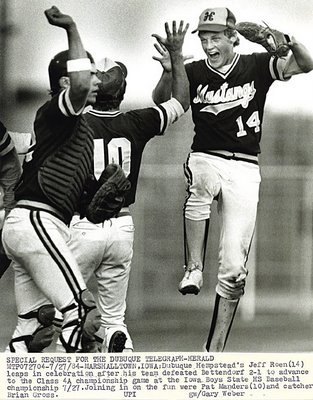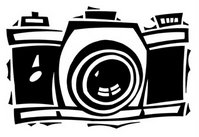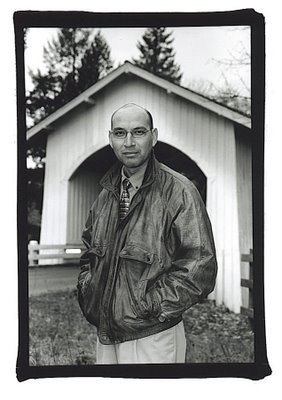An Analog Log, Part II
In the digital age with today's technology, all a newsphotographer needs to cover an assignment and file images from a remote location in a matter of minutes(possibly even seconds!)is a digital camera, laptop computer, and a telephone. To offer some perspective on how significant these advancements are from the past, and to clarify and expand upon last week's post, let's revisit the Iowa Boys State High School Baseball Tournament one year later . . .

7/27/84, Marshalltown, IA (UPI): Another baseball season has ended, new teams have emerged to compete for the title, but the assignment's location and logistics remain the same. In addition to your camera equipment and supplies(i.e., Kodak 35mm Tri-X film and Ilford 8x10" Multigrade RC photo paper), these are the necessities to cover the job from your temporary "photo bureau"(i.e., motel room):
A Darkroom: Without exception, the bathroom--as it offered two mandatory requirements: a source of water and a light-tight space. If the sink was located outside of it, water could be used from the bathtub or carried by buckets into the room. If the space wasn't light-tight, black plastic sheeting was duct-taped over the leaks.
A Darkroom Kit: A traveling case was typically no more than 20"x30"x10" deep in size, and bear in mind, all of your film and paper processing equipment and supplies needed to fit inside of it! The kit included:
Chemicals - Liquid or powder concentrates were the first choice for ease of handling and packing, and they could be mixed to quantity on location. For quick one day shoots, pre-mixed individual plastic bottles were packed, but in any event, a wire photog needed to carry film developer(Kodak D-76 or HC-110, or Acufine), fixer/hypo(the same concentration was used for film and paper), paper developer(Kodak Dektol), and Kodak Photo-Flo for film.
Film Processing - All of the following components: a 4 reel developing tank, 4 35mm film reels, a darkroom graduate, thermometer, a timer, a hair-dryer(used for film and paper), and a lupe magnifier, paper punch, and scissors for editing.
Paper Processing - These items comprised the bulk of the kit: a portable enlarger(I chose a Unicolor 35mm with a Nikon 50mm/F 2.8 lens, as its column and baseboard were under 30" long to fit inside the case although this reinforced the need to shoot everything full frame!), a spare enlarger bulb(they burned out at the worst possible times!), an enlarging timer(however, frequently I just timed exposures in my head--1000-1, 1000-2, etc.), a set of Ilford Multigrade filters, an 8x10" UPI speed easel, a dodging tool, an attachable safelight, 3 8x10" processing trays, towels for a print squeegee and the hair dryer for print drying were already included, and finally a spotting kit for minor print imperfections.
Journalistic Tools: Once the film was edited and a high-quality print produced, the culmination of the assignment was delivering(as quickly as possible, I might add!)a fully captioned and publishable image to your network of clients. A small, manual typewriter and letter-sized adhesive labeling provided the caption and other pertinent information, and the UPI domestic transmitter did the rest. Simply put, with a print attached to its revolving drum, a light sensor scanned tonal values creating sound impulses that were decoded by a receiving printer on the opposite end which produced a facsimile print of the original image. This was done by hardwiring the transmitter to a telephone(normally through the receiver using alligator clips on the inside prongs of the mouthpiece)and for an 8x10" print, the transmission process lasted about 8 minutes. A color photograph(or project, as it was called)required 3 separate scans(for the magenta, cyan, and yellow printers)and lasted nearly half an hour--but that's another story. Needless to say, an inordinate amount of time was spent using the telephone lines to deliver images across the network(taking into account poor reception quality or power surges that resulted in defects, hits, or other circumstances that rendered photos unusable), and a wire service's long distance usage certainly accounted for some serious coin in the telephone industry!
But, when everything went off as envisioned or planned, there was no singular greater feeling(for a UPI photographer at that time)than witnessing the fruits of your labor as a stack of published clips from dual wire service newspapers--that is truly how it was!


7/27/84, Marshalltown, IA (UPI): Another baseball season has ended, new teams have emerged to compete for the title, but the assignment's location and logistics remain the same. In addition to your camera equipment and supplies(i.e., Kodak 35mm Tri-X film and Ilford 8x10" Multigrade RC photo paper), these are the necessities to cover the job from your temporary "photo bureau"(i.e., motel room):
A Darkroom: Without exception, the bathroom--as it offered two mandatory requirements: a source of water and a light-tight space. If the sink was located outside of it, water could be used from the bathtub or carried by buckets into the room. If the space wasn't light-tight, black plastic sheeting was duct-taped over the leaks.
A Darkroom Kit: A traveling case was typically no more than 20"x30"x10" deep in size, and bear in mind, all of your film and paper processing equipment and supplies needed to fit inside of it! The kit included:
Chemicals - Liquid or powder concentrates were the first choice for ease of handling and packing, and they could be mixed to quantity on location. For quick one day shoots, pre-mixed individual plastic bottles were packed, but in any event, a wire photog needed to carry film developer(Kodak D-76 or HC-110, or Acufine), fixer/hypo(the same concentration was used for film and paper), paper developer(Kodak Dektol), and Kodak Photo-Flo for film.
Film Processing - All of the following components: a 4 reel developing tank, 4 35mm film reels, a darkroom graduate, thermometer, a timer, a hair-dryer(used for film and paper), and a lupe magnifier, paper punch, and scissors for editing.
Paper Processing - These items comprised the bulk of the kit: a portable enlarger(I chose a Unicolor 35mm with a Nikon 50mm/F 2.8 lens, as its column and baseboard were under 30" long to fit inside the case although this reinforced the need to shoot everything full frame!), a spare enlarger bulb(they burned out at the worst possible times!), an enlarging timer(however, frequently I just timed exposures in my head--1000-1, 1000-2, etc.), a set of Ilford Multigrade filters, an 8x10" UPI speed easel, a dodging tool, an attachable safelight, 3 8x10" processing trays, towels for a print squeegee and the hair dryer for print drying were already included, and finally a spotting kit for minor print imperfections.
Journalistic Tools: Once the film was edited and a high-quality print produced, the culmination of the assignment was delivering(as quickly as possible, I might add!)a fully captioned and publishable image to your network of clients. A small, manual typewriter and letter-sized adhesive labeling provided the caption and other pertinent information, and the UPI domestic transmitter did the rest. Simply put, with a print attached to its revolving drum, a light sensor scanned tonal values creating sound impulses that were decoded by a receiving printer on the opposite end which produced a facsimile print of the original image. This was done by hardwiring the transmitter to a telephone(normally through the receiver using alligator clips on the inside prongs of the mouthpiece)and for an 8x10" print, the transmission process lasted about 8 minutes. A color photograph(or project, as it was called)required 3 separate scans(for the magenta, cyan, and yellow printers)and lasted nearly half an hour--but that's another story. Needless to say, an inordinate amount of time was spent using the telephone lines to deliver images across the network(taking into account poor reception quality or power surges that resulted in defects, hits, or other circumstances that rendered photos unusable), and a wire service's long distance usage certainly accounted for some serious coin in the telephone industry!
But, when everything went off as envisioned or planned, there was no singular greater feeling(for a UPI photographer at that time)than witnessing the fruits of your labor as a stack of published clips from dual wire service newspapers--that is truly how it was!



0 Comments:
Post a Comment
<< Home